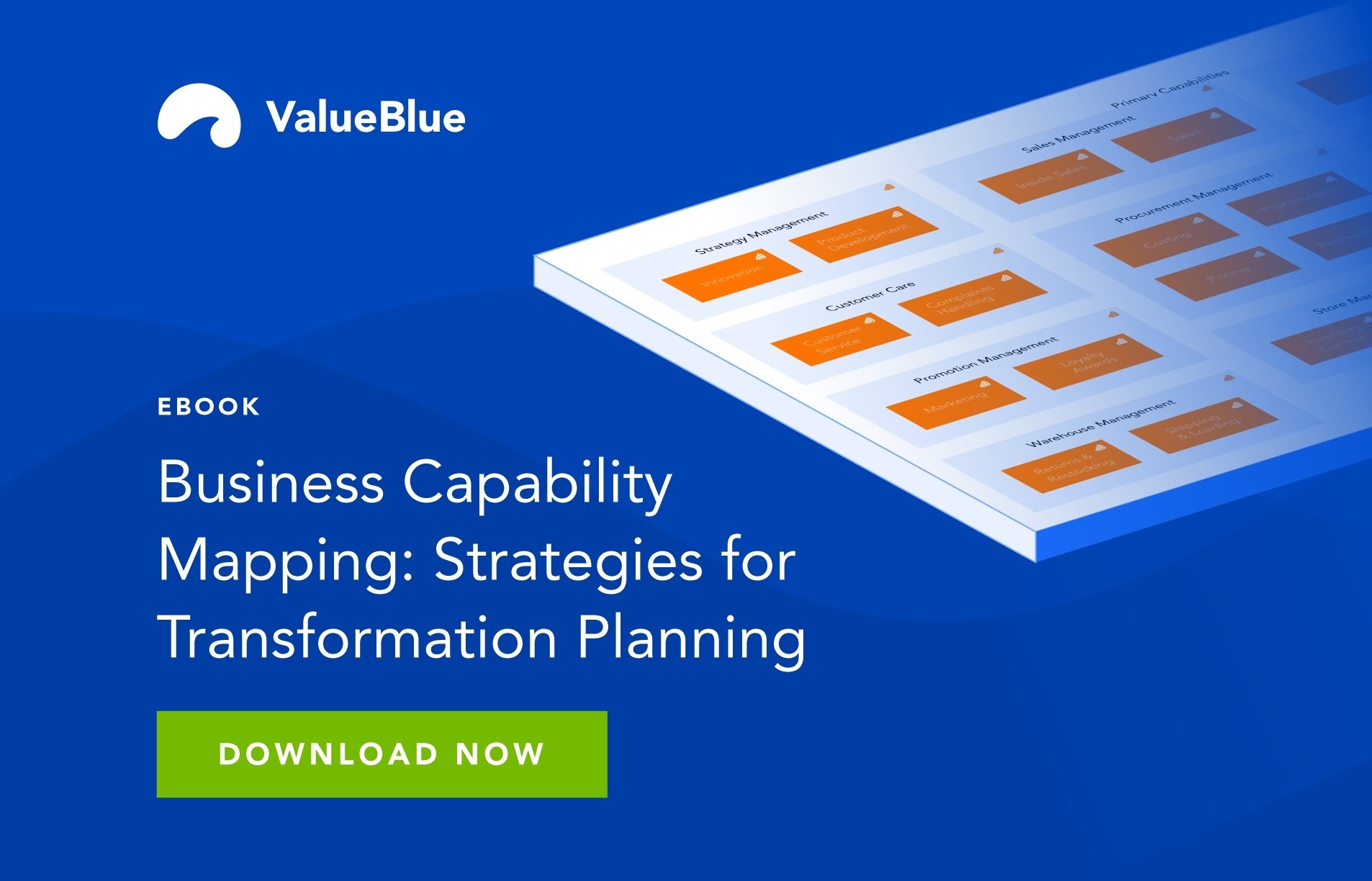Strategic vs Tactical Planning in Enterprise Architecture
In ever-evolving commercial landscapes, companies find themselves in a constant state of transformation – driven by an urgent need to innovate and to adapt. From replacing legacy systems to introducing groundbreaking products to market, successful transformations demand a nuanced understanding of the organization’s entire enterprise architecture. It should come as no surprise that the approach to planning these transformations will vary significantly, based on the nature and objectives of any given project.
In this article, we’re going to consider two approaches to transformation planning – strategic and tactical – reviewing their characteristics, and taking a look at the steps Enterprise Architects can take to make a success of each.
What is strategic planning?
Strategic planning — in contrast to tactical changes aimed at optimizing current state architecture — is typically reserved for complex transformations that align with the broadest level of organizational objectives and strategy. Truly strategic initiatives typically first require the creation of a revised, future-state architecture, and then the design of appropriate new solutions – followed, of course, by the implementation of these new solutions.
Characteristics of Strategic Planning
- Focus on the Future (State): Strategic planning looks beyond the current state of the organization, concentrating on defining a future-state architecture that aligns with the long-term vision and goals.
- Based on Business Objectives: The primary goal of strategic planning is to align the enterprise architecture with broader business objectives. The practice of strategic planning ensures that architectural decisions directly contribute to the realization of the organization's strategy.
- Drive Innovation Forward: Strategic planning should truly foster organizational innovation — by envisioning new and transformative solutions. It encourages organizations to explore cutting-edge technologies and methodologies that can drive significant change in their market.
- Examine the Entire IT Ecosystem: Strategic planning does demand a holistic approach; the consideration of the organization’s entire ecosystem. It challenges you to look beyond individual projects or departments, and should reward you with a cohesive and integrated architecture.
Strategic Planning with Enterprise Architecture, Step-By-Step
Step 1: Analyzing Drivers for Change
The initial phase of planning strategic transformation involves a thorough analysis of the drivers instigating the change. Understanding the unique factors at play and how they align with new business goals is crucial at this stage. Given the diversity of these drivers, employing a variety of analytical approaches is going to be necessary. Consider, for example, external factors influencing the market as well as your current customer journey (and check out the variety of BlueDolphin templates designed to capture and assess these insights).
An example of analyzing drivers for change using BlueDolphin. Here, we’re using the Customer Journey template to analyze the processes and apps integral to servicing customers online.
Step 2: Capturing Business Goals
Once the drivers behind the transformation are identified, your focus can shift to capturing new business goals and/or strategic objectives. Enterprise Architecture should be playing a key role in helping C-level executives to define them. Here are three ways in which EA teams contribute to this process:
- Share Insights: Communicate insights from your current state analysis with the executive team to inform goal-setting.
- Collaborate on Goal Definition: Work collaboratively to define new goals based on your organization’s capability model, and safeguard alignment with the overall strategy.
- Use EA Tools: Leverage EA tools such as BlueDolphin to systematically capture business goals and vision, and to facilitate a structured and organized approach to your strategic planning.
-1-1.png?width=300&height=424&name=eBook_Guide%20to%20Strategic%20Planning_7%20pages%20(1)-1-1.png)
Strategic Planning with Enterprise Architecture
Value delivered from transformation projects often falls way too short of expectations - research shows only 31% of expected revenue increases and 25% of cost savings are achieved. Increase the business value of your transformations with strategic planning for EA.
What is Tactical Planning?
Tactical planning within the context of enterprise architecture involves taking a focused and practical approach to optimizing your existing systems, processes and technology. Unlike strategic planning, tactical planning addresses the immediate needs of the organization. It's a dynamic process that aims to continuously enhance your organization’s efficiency, help resolve its current challenges, and deliver quick wins. What tactical planning is unlikely to do is significantly move your strategic needle.
Characteristics of Tactical Planning
- Look at the Here-and-Now: Tactical planning centers on short-term objectives that align with the organization's current priorities. It doesn’t get caught up in three-, five-, or ten-year roadmaps. It involves making incremental improvements to the existing architecture to address immediate pain points.
- Lift Operational Efficiency: The primary goal of tactical planning is to enhance operational efficiency. This could comprise streamlining processes, improving system performance, or addressing process bottlenecks within the current process architecture.
- Quick Wins, Rapid Gains: Tactical planning often involves identifying opportunities for quick wins. These are tangible, immediate improvements that provide visible benefits to the organization, fostering a sense of progress and accomplishment.
- IT-Business Unit Synergy: Successful tactical planning requires close collaboration between IT teams and business units. It's essential to gather insights from both sides to identify areas for improvement and align tactical objectives with business needs.
Tactical Planning with Enterprise Architecture, Step-by-Step
While strategic planning does set the stage for large-scale transformation, tactical planning is unsurprisingly equally crucial for optimizing existing systems and ensuring operational efficiency within the organization – a day-to-day for many enterprise architects .
Step 1: Analyzing Current State Architecture
Before you dive into tactical planning, it's vital to conduct a thorough analysis of the current state architecture. This involves assessing the strengths and weaknesses of your organization’s capabilities – as well as the applications, processes, data and infrastructure enabling those business capabilities. Utilizing an EA tool like BlueDolphin lets you create visual representations of your current state and a clear overview of the existing landscape. This step (and we’ve more ‘how-to’ guidance here) sets the foundation for informed decision-making in any subsequent tactical planning.
Step 2: Identifying Short-Term Objectives
With insights from the analysis phase, the next step in tactical planning is to identify short-term objectives. These should complement immediate business priorities and aim to enhance specific aspects of the current architecture. Whether it's upgrading legacy applications, identifying and mitigating data risk, or implementing new systems, the focus should be on making targeted adjustments that yield tangible and immediate benefits.
Balancing Act: Integrating Strategic and Tactical Planning
Having taken that whistle-stop tour of the ins and outs of strategic vs tactical planning, it should come as no surprise to Enterprise Architects that creating synergy between your strategic and your tactical planning is the key to helping your organization develop resilience and agility.
Striking the Right Balance
- Long-Term Vision vs. Immediate Needs: Strategic planning focuses on the long-term vision of the organization, aligning architecture with overarching goals. Tactical planning addresses immediate needs, ensuring the organization remains responsive to current challenges.
- Innovation vs. Efficiency: Strategic planning drives innovation by envisioning future-state architectures. Tactical planning enhances efficiency by addressing immediate pain points and optimizing existing processes.
- Collaboration across Teams: Both planning approaches require collaboration across IT, business units, and executive teams. Enterprise Architecture teams, as ever, play a central role in facilitating communication and ensuring alignment between strategic and tactical initiatives.
Conclusion: Orchestrating Success
By utilizing an Enterprise Architecture platform like BlueDolphin, organizations can streamline both the strategic as well as the tactical planning processes and ensure an appropriate balance of the two.
By maintaining a close grip on insights from the current state, EA and operational teams can remain adaptable and ready to act on tactical improvements. By mapping, understanding, and assessing the entire current state architecture, teams can flag risks and streamline inefficiencies in processes, applications, data, or technology infrastructure.
Strategically, teams can consolidate high-level goals and objectives, create and adjust business- and operating model- canvases, and detail the design of effective solutions, based on business capability requirements.
By relying on complete and data-driven insights, Enterprise Architects can direct the organization towards an optimized future state architecture, and ensure the delivery of new and innovative solutions.
Want more strategic planning for Enterprise Architecture? Don’t miss our eBook: A Guide to Strategic Planning with Enterprise Architecture.
eBook: A Guide to Strategic Planning with Enterprise Architecture
This eBook explores an architecture-driven and holistic approach to strategic planning of transformations.
Download the eBook to explore:
- Why transformations happen and the role of Enterprise Architecture
- How to analyze drivers for change and capture business goals
- How to construct a business model canvas and define your future-state architecture
- Capability-based planning
- Prioritizing projects based on strategic importance.
.png)



-1-1.png?width=166&height=235&name=eBook_Guide%20to%20Strategic%20Planning_7%20pages%20(1)-1-1.png)